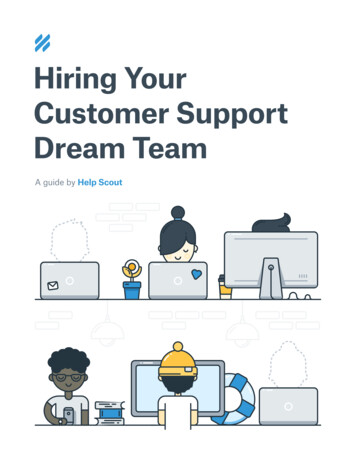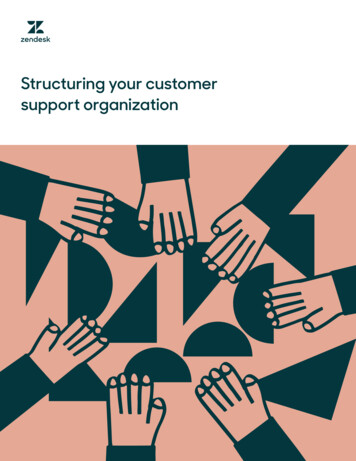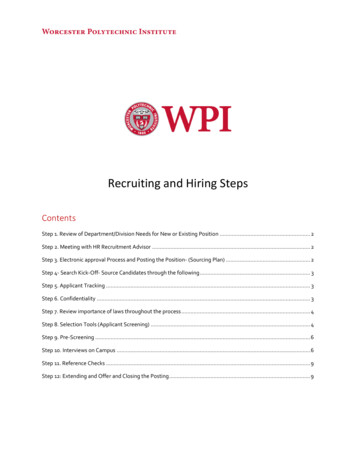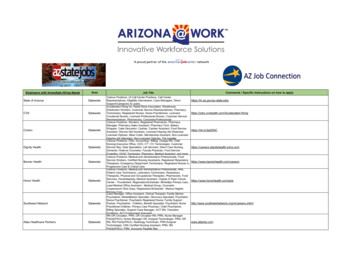
Transcription
Hiring YourCustomer SupportDream TeamA guide by Help Scout
Special thanksTo Cassandra Marketos for her extensive efforts in interviewing contributorsand authoring this handbook. To Emily Triplett Lentz and Stephen Murrill forproviding editing and design polish. To all of our generous contributors fortaking the time out of their day to share what they know.And a personal thanks to you for reading. By doing so, you’ve advanced thecontinued push for great customer support. You know building a world-classsupport team is serious business, and you made time to learn more about theprocess to improve your own approach. We can only hope that this book willhelp you hire the best support team around.Stay in touch: On Twitter (@HelpScout) On our Facebook Page Or send us an email2
Table of Contents1.The Personality62.The Search113.The Resume174.The Interview215.The Onboarding276.The Team34Conclusion393
A New Era forCustomer SupportIn many ways, the discipline of support is currently experiencing arenaissance. The days of one-and-done sales are slowly giving way torecurring revenue models, and with their departure goes the archaic view ofsupport as a mandatory cost of doing business. Now, support as a specialtyis finally coming into its own as a competitive advantage; perhaps one of themost difficult differentiators for competitors to copy.With the evolution of the role comes a growing need for a growing set ofskills. As we hope this book makes clear, a talented support teammate iscurrently leagues beyond the call center stereotype of old, and the gap willonly get wider. The breadth of skills needed to succeed means “supportunicorns” now exist—this is no longer a entrylevel, leapfrog position, but an opportunity tobuild a sustainable career with its own fulfilling“The quality of yourtrajectory.customer support will neverWe say this to counterbalance the currentdiscussion around “what’s next” for customerexceed the quality of thepeople providing it.”service—a conversation dominated by tech,tech, and oh, more tech. What most people aremissing is that automation, customer data, andsmart tools will always work best to enrich, not replace, human-to-humanexperiences. They’ll enable us to reduce customer effort, provide proactivesolutions, and help us help customers even faster. But with great power4
comes great responsibility, and the people behind these processes willdetermine their success or failure. And let’s not forget, whenever technologylets us down, we’ll always want a friendly human to pick us back up.Put another way, the quality of your customer support will never exceed thequality of the people providing it.That’s why we wrote this book: to help you build the best support team you’reable. We’ll start off with who to look for, and take you all the way through tosupporting your new teammates with effective, considerate onboarding. Theyare, after all, the voice of your company and your customers. There’s no roomfor anything less than excellence.Enjoy the book!—The Help Scout team5
Chapter OneThe PersonalityFinding the perfect hire for a support team can be challenging, to say theleast. No particular checklist of job experiences and college diplomasadds up to the perfect candidate. Instead, you’re looking for qualities thatcan’t necessarily be taught. These folks thrive on one-on-one interactionswithin their community. They love problem solving. They’re warm,approachable, have a relatable voice, and they’re great at teaching otherpeople how things work. When thinking about it this way, finding a greatcustomer support rep kind of sounds like looking for a good buddy. Funnilyenough, the qualities that make for a good pal often line up with the qualitiesthat make for a good support teammate.6
Not convinced? Let us break it down for you. Here are six qualities you’ll findin a top-notch customer support rep-to-be.1. They are emotionally intelligentA great customer support representative knows how to relate to anybody,but they’re especially good with frustrated people. Instead of taking thingspersonally, they intuitively understand where the other person is comingfrom and they know to both prioritize and swiftly communicate that empathy.Think about it: how often have you felt better about a potential grievancesimply because you felt immediately heard by the other person involved?When a support rep is able to demonstratesincere empathy for a frustrated customer,Bonus: this quality goes a longeven just by reiterating the problem atway even in cases where the issuehand, it can help to both placate (thecustomer feels heard) and actively please(the customer feel validated in theirat hand—hello, startups—cannotbe immediately solved.frustration).2. They are problem solversNo news flash here, but customers do not always self-diagnose their issuescorrectly. Often, it’s up to the support rep to take the initiative to reproducethe trouble at hand before navigating a solution. That means they need tointuit not just what went wrong, but what action the customer was ultimatelyafter. A great example? If somebody writes in because they’re having troubleresetting their password, that’s ultimately because they want to log intotheir account. A good customer service interaction will anticipate that need7
and might even go the extra mile to manually perform the reset and providenew login details, all while educating the customer on how they can do it forthemselves in the future.In other situations, a problem-solving pro may simply understand how tooffer preemptive advice or a solution that the customer doesn’t even realize isan option.3. They are good communicatorsYour customer support team is on the front lines of problem solving for theproduct itself, and serves as a kind of two-pronged bullhorn. On one side,they’ll be the voice of your company to your customers.That means they have to have a practiced graspon how to reduce complex concepts into highly digestible,easily understood terms.On the other, they’ll represent the needs and thoughts of customers to yourcompany. For example, it doesn’t behoove the customer to receive a longwinded explanation on the ins-and-outs of solving a particular bug. (I’ve seenthis before.) What’s better? “Our team is striving to solve the issue quicklyand we expect resolution within the week.” Friendly, honest, and—mostimportantly—brief.8
4. They are methodicalIn customer service, haste makes waste. Hiring deliberate, detail-orientedpeople will go a long way in meeting the needs of your customers. One,they’ll be sure to get to the real heart of a problem before firing off a reply.(There’s nothing worse than attempting a “solution,” only to have it missthe mark entirely on solving the actual issue.) Two, they’ll proofread. Athoughtfully written response can lose a lot of its problem-solving luster if it’sriddled with typos. Three, and this one may be the most important, it meansthey’ll regularly follow up. There’s nothing moreimpressive than getting a note from a customerservice rep saying “Hey! Remember that bug youfound that I said we were looking into? Well, wefixed it.” That’s a loyal, lifetime customer you’vejust earned.An important side note:The best hires are able tomaintain their methodicalgrace under regular fire.Since the support team is often tasked with thetough work of cleaning up other people’s messes,it’s especially important they understand hownot to internalize the urgency—and potential ire—of frustrated customers.Instead, they know how to keep a cool head and a steady, guiding hand.5. They are creative and resourcefulSolving the problem is good, but finding clever and fun ways to go the extramile—and wanting to do so in the first place!—is even better. It takes panacheto infuse a typical customer service exchange with memorable warmth andpersonality, and finding a customer service rep who possesses that naturalzeal will take your customer service out of “good enough” territory and9
straight into “tell all your friends about it” land. (And trust us, that land iswhere you want to be.)Chase Clemons at Basecamp advises the following:“You want to have somebody that you don’t have to give a lot of rules andregulations to. You want to have somebody who is talking to a customerand understands ‘Their boss is really yelling at them today. This personis having a really bad day. You know what? I’m going to send them someflowers to brighten things up.’ That’s not really something you can teach.They have to go the extra mile naturally.”6. They are excellent writersGood writing means getting as close to reality as words will allow. Withoutan ounce of exaggeration, being a good writer is the most overlooked,yet most necessary, skill to look for when it comes to hiring for customersupport. Unlike face-to-face (or even voice-to-voice) interactions, writingrequires a unique ability to convey nuance. How a sentence is phrased canmake the difference between sounding kind of like a jerk (“You have to logout first”) and sounding like you care (“Logging out should help solve thatproblem quickly!”). Good writers also tend to use complete sentences andproper grammar—qualities that subtly gesture toward the security andtrustworthiness of your company.Even if your company offers support primarily over the phone, writing skillsare still important. Not only will they enable your team to craft coherentinternal documentation, they signify a person who thinks and communicatesclearly.10
Chapter TwoThe SearchWhat’s one of the most overlooked parts of finding a great candidate?Here’s a secret: it’s not the vetting process. It’s attracting a diverse,competent, and exciting group of prospects in the first place. The best way todo that? Write a killer job listing.Attracting talented people starts with communicating that there ismeaningful work to be done. Extraordinary people won’t take ordinaryjobs. Too often we forget that a job posting is the first impression. Don’t letexcitement to fill an open position result in wording that sounds lazy, selfish,overused, or out-of-touch.11
Crafting a compelling description of your desired hire will set the precedentfor the people who apply, but more importantly, it will also encourage peopleto share, extending your reach by miles and upping your chances to collidewith the person who feels just right.Remember the following as you create job listings to attract your idealcandidates.1. Be thoughtful about your titleThis can be tricky. You want a job title that stands out to people while stillbeing easy to find via Google, which can force you to rethink the internalsemantics of your company a bit. Job titles that may be true to the spiritof your company (think “ninja”) can undermine a potential hire’s ability tounderstand what it is you are actually looking for. But while it’s important tocommunicate across industry standards, itdoesn’t mean you have to give up all hope ofbeing interesting.“You want a standout amongThe trick? Maintaining a 70/30 approach.That means using a majority of searchable,candidates, right? So make sureyou stand out, first.”relevant, plainspoken keywords, plus a singledash of something interesting that will makethe listing hook eyeballs. Help Scout job posts, for example, include a lineabout how our culture isn’t “built around ping-pong tables or Xboxes; it’s allabout the work.” That may make some people smirk, sure, but it makes ourkind of people look twice.12
2. Mix it upPeople expect job descriptions to be dry, boring, cut-to-the-chase lists ofskillsets and experiences, which makes them a chore to get through andmeans you could be losing 50% of your best candidates before they’re evenhalfway down the page. It’s important to keep in mind that there is no actualstandard and that most of what you see out there is a kind of uncertainmimicry—companies imitating each other because, perhaps like you, theysimply have no idea what to say.Remember that there’s an incredible range of resources available(media types, platforms, even font sizes) that can make your joblisting pop.Introducing some unusual elements will help get people’s attention, motivatethem to apply, and (major bonus) inspire them to share amongst their ownnetworks. Think of it this way: you want a standout among candidates, right?So make sure you stand out, first.3. Focus on the most important skillsWhen it comes to a job listing, less is definitely more. Customer servicebenefits from a core set of skills—writing competence, problem solving,and a strong sense of empathy—which don’t necessarily require a degreeor extensive experience in the industry. You’ll cast a wider net if you scrapeaway the arbitrary requirements and stay focused on what really matters.13
4. Be true to the voice of your companyJust as you want to stand out visually, it’s important to have a singular anddistinct company voice. Skip the jargon and speak directly to the person youwould hope to hire, as if you’re talking to a new friend. Unlike other parts ofthe hiring process, there’s no template for how this sounds. Instead, thinkhonestly about how you would describe your company. Are you sincere?Playful? Academic? The job listing you write should reflect all those qualitiesso that you’re sure to attract a like-minded applicant.A particularly good example of this is Kickstarter’s recent call-to-hire a newexecutive assistant. The posting is extremely personal—coming from theirCEO’s own Medium account—distinctly lo-fi and candid. Strickler discussesthe interpersonal challenges of the role frankly and in plain language:“The two biggest challenges I see for the role: 1) managing andprioritizing requests for my time, and 2) managing me. While managingand prioritizing requests for my time is a huge part of this role, I stillfind the whole needing-an-assistant thing kinda strange. You’ll needthe experience and comfort to jump in and take the reigns, rather thanwaiting for me to ask.”This type of listing will stand out to a certain type of hire for its forthrightnessand its narrative, almost letter-like approach. It’s also guaranteed to connectdeeply with the exact type of person Strickler is seeking: somebody who isalso candid, warm, and straightforward.14
5. Be conscious of diversityIt can be easy to create a job listing that serves as a kind of feedback loop,appealing to the exact type of person that already inhabits the ranks of yourcompany, at the expense of other, equally as capable candidates who mayhave different types of job experience and general backgrounds. There aremany wonderful resources that will help you weigh what to add (and what toleave out) of a job description in order to create a thoughtful, inclusive listing.Tools like Textio can also help you assess your resumes for content and seehow they stack up against others.6. Don’t be afraid to bragThis goes almost without saying, but you’re proud of your company andyou’ve worked hard to create a culture that your employees will enjoy. Don’tbe afraid to spotlight that in a job listing! Afterall, you’re aiming to inspire people to apply, andyou want them to be excited about the prospectof working with you, not just getting a paycheck.A great example of a job listing that wins majorpoints for shouting out company culture is thisrecent post for a support specialist from Trello.After detailing requirements and outliningexpectations, they dedicate a full paragraph to“After all, you’re aimingto inspire people to apply,and you want them to beexcited about the prospectof working with you, notjust getting a paycheck.”describing what it’s actually like to work at Trello:“Trello was built to be an awesome place to work.We treat employees like royalty. We care deeply about your professionaldevelopment and long term goals. We work with you to grow your skills bothin and outside support.”15
Now, doesn’t that make you feel excited? Doesn’t that make Trello sound likea place where you’d be jumping to work? Exactly.At the end of the day, your job listing functions asyour first line of defense.Putting in the time and effort to make sure it’s compelling, shareable, andabove all, true to the voice and mission of your company will ensure youattract candidates who align with your most fundamental values.16
Chapter ThreeThe ResumeParsing a pile of resumes can be a little like, well, swiping right. You’rejudging a pile of candidates based on a set of superficial criteria, likewhat companies they’ve worked for and how many extracurricular skills theyhave, when what you really need to know is something altogether different:“Are they kind? Will they thrive?”Here’s how Basecamp’s Chase Clemons puts it:“I can teach you how to use the product, I can teach you how to lookup a customer’s account or look at a bug. I can’t teach you things likepersonality. Personality is really, really key with customer service. Youwant somebody who is always going to be upbeat, cheerful, and alwayssmiling.”17
These qualities are certainly more abstract than the number of years of priorexperience, but that doesn’t mean they’re impossible to find in a resume.It can just take a little extra elbow grease—and subtle intuition—to filterthrough the mediocre candidates and find the superstars: those potentialhires who stand out on the merits of their originality, creativity, and individualvoice.Here are some helpful insights on how to do just that.1. Look twice at the cover letterReading a cover letter should be a pleasure, not a chore. If somebody canpresent their personality and past work in a fresh, interesting, and highlyreadable way, imagine how they’d spruce up an everyday customer serviceinteraction. (Hint: they’ll provide the kind of notable service that customerswill talk to their friends about.) So read the cover letter and ask yourself,“Was I bored?” If the answer is yes, it’s probablybest to give that person a pass for now. If you findyourself excited by somebody’s cover letter, though,you’ve also found somebody who is a naturalconversationalist—a quality that translates directly to“Reading a cover lettershould be a pleasure,not a chore.”memorable, positive customer service interactions.Another thing to look for? According to Trello’s Ben McCormack, applicantsshould address what specifically interests them about support: “It’s a filterto get rid of people who aren’t going to be a good fit. Sometimes, we willhave people who are huge fans of Trello, but they don’t say anything aboutsupport. That’s a disconnect already.”18
It almost goes without saying that any grammar issues, typos, or incompletesentences get an automatic “pass.”2. Look for unique interpretationsSome candidates will make an effort to ensure that their resume stands out,whether that means making a pinata shaped like your company logo, creatinga unique animation, or writing you a song (seriously!). These things areobvious once you see them, of course, but it sometimes takes a reminder thatyou can and should expect them. Take this anecdote from Chase Clemons atBasecamp:“Make it unique. One woman that we hired actually went out and did a‘Day in the Life’ video, so we could get an idea of how she was using hercustomer service skills in her existing job, as a librarian. She basicallytook a GoPro video camera with her and said ‘Here’s how I help people inmy job now!’ Building a resume that is more than standard—that showscreativity and individuality—is really impressive. You want what you aredoing to stand out!”Somebody who goes the extra mile to design a resume that’s also anexperience is obviously somebody who will not only enjoy the work, they’llbecome an active contributing voice to a company culture that is vibrant andsustainable.19
3. Make sure they’re fans!As an extension of the point above, it should be clear that a potential hire isnot copying and pasting information from one resume to the next.Instead, they should present work that is tailored directly to your companyand demonstrate
product itself, and serves as a kind of two-pronged bullhorn. On one side, they’ll be the voice of your company to your customers. On the other, they’ll represent the needs and thoughts of customers to your company. For example, it doesn’t behoove the customer to receive a lon











